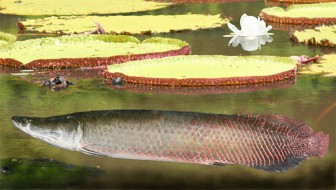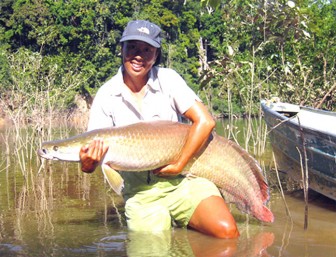Rain forests are rich in biodiversity and are home to many different plants and animals. In addition, indigenous communities make their homes there. Even if you don’t live in the rain forest, humans rely on the forest for resources such as building materials (wood and lianas), medicine and fruits. Rain forests also provide essential environmental services for life on earth; they create soil as well as prevent soil erosion, produce oxygen though photosynthesis, maintain clean water systems, and are a key defence against climate change. The Iwokrama Rain Forest is 371,000 hectares, located in the heart of Guyana. Our mission is to develop strategies for conservation and sustainable development for local people in Guyana and the world at large. We are involved in tourism, training, research and our timber is certified by the Forest Stewardship Council. Come and visit us in the rain forest or at http://www.iwokrama.org.

The Arapaima (Arapaima gigas) is the largest scaled fresh water fish in the world. Native to South America it can grow up to 2 metres and weigh over 100 kg. It is a prehistoric looking fish, greeny gold in colour with red tipped scales, tail and dorsal fins. In keeping with its unique appearance is unique behaviour; the Arapaima is an obligate air breather, meaning that it must surface to breathe air and will drown underwater. The reproduction of Arapaima depends on the seasonal ebbs and floods of rivers and lakes, during the dry season, the female makes a round depression about 1 metre across on the muddy bottom of a pond where she lays her eggs. As the rains begin and the ponds and rivers start to swell, the eggs hatch and then the male Arapaima takes over minding the brood; he secrets a milky hormone from the top of his head and this keeps the small fry around him. As water levels flood, food sources are abundant for the fry but so are predators and when danger approaches, he gulps all the fry into his mouth and holds them there until danger passes, the female swimming around protectively.

The Arapaima’s large size and fleshy meat has resulted in over hunting and harvesting for meat, and it is now listed as endangered by the International Union for Conservation of Nature (IUCN). However, in the rivers and ponds of Iwokrama and the North Rupununi, thanks to a community-based conservation and management plan for these fish, populations are growing in the Rupununi River.
For the past 10 years, the fisheries committee of the North Rupununi District Development Board (NRDDB) has monitored and managed the population of the fish in the North Rupununi; based on the local population status they wrote and implemented the Arapaima Management Plan which included a local ban on fishing Arapaima. The plan was presented and was passed by cabinet in December 2007 and is the only inland fisheries plan in Guyana. The implementation of the plan has been so successful, the population of the fish has increased over 700%, and between December 2009 and January 2010 the Ministry of Agriculture granted permission to the NRDDB fisheries committee to harvest 101 adult Arapaima over 1.5m in length. Profits from the harvest are to support ongoing monitoring and management of the Arapaima in the North Rupununi.




